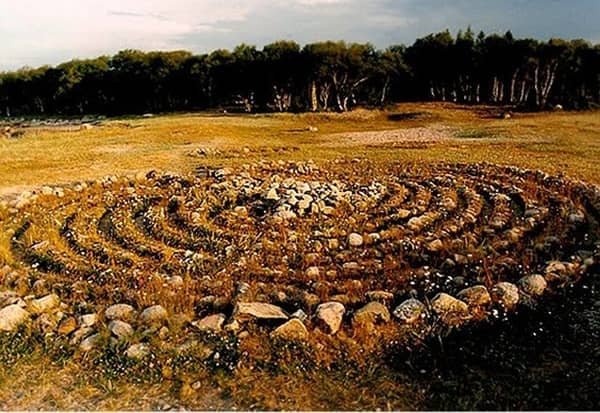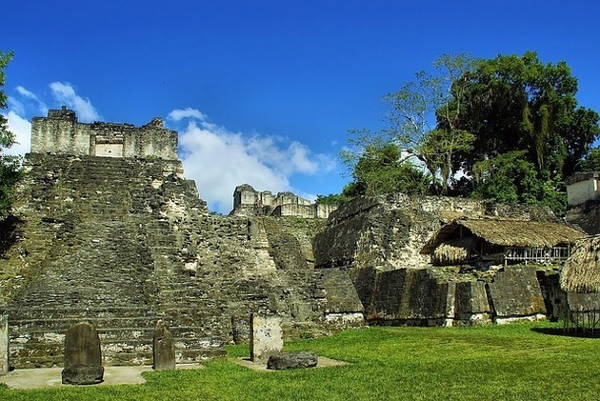Landmarks can be natures footprint or man’s intention. While monuments are known to be used as a mark in history, they can serve more than a single purpose. Humans have been building incredible monuments since prehistoric times, and many of them were built mysteriously, we still haven’t figured out why. This article will take you through 10 of the most mysterious landmarks of all time.
10. Stone Labyrinths of Bolshoi Zayatsky, Russia

The stone labyrinths are located on Bolshoi Zayatsky one of the Solovetsky Islands in Arkhangelsk Oblast, Russia. A labyrinth is a complex network of pathways or passages that form a maze-like structure which only has one path, differentiating it slightly from a maze. The Solovetsky Islands located in the White Sea can be found decorated with these labyrinths with as many as 14 of them found on Bolshoi Zayatsky Island alone. The stone labyrinths are known to the Russians as Vavilons (Babylons in English) and normally don’t reach much higher than 40 cm. Many believe that the credit for these prehistoric labyrinths belongs to an ancient civilization that was more advanced.
A grand total of 35 labyrinths can be found on Russia’s Solovetsky Islands. They are normally found towards the west, while the east normally features intricate stone formations without labyrinths such as those found on Sopka hill.
According to researchers the formations are at least 2500 years old. The purpose is not known for sure, but many theories conclude that they may have been used spiritually as ritual formations, to allow spirits to cross over into the next life. Others say they may have been used as fishing traps, but this theory was dismissed early on.
9. Stonehenge, England

Stonehenge is a large prehistoric set of assembled stones built by ancient Britons. The structure is in Wiltshire, England and has been noted as one of the oldest man-made monuments on the planet. The individual stones weigh much more than any human could carry with the lightest one weighing up to 3.6 tons while the larger supporting stones are estimated at 25 tons. This leaves many speculating who could’ve built it and how it was built.
The archaeological monument is over 5000 years old, opening much room for interpretation on its purpose at such a period in earth’s existence. Scientists have been researching Stonehenge since the mid-1600s and while we have learned much more about it, we are still left with many unanswered questions.
Many legends have been formulated with the most popular theories suggesting that giants sculpted the monument with their immense strength, size and height. Alternative theories state that Merlin used his sorcery to levitate the huge stones into place. While some say giants helped Merlin build it.
8. The Great Sphinx, Egypt

The Great Sphinx is in Giza, Egypt. It is anywhere from 4500-7000 years old with many researchers believing that it was built to resemble Khafre, the Pharaoh at the time. Khafre ruled during what was known as the 4th Dynasty. While not much is known about him, ancient reports suggest that he was a very cruel leader.
Sphinxes are creatures with the body of a lion and a woman’s head, although the Sphinx of Giza was instead built with a man’s head, as per the Egyptian definition. The structure has a height of 20 meters, a length of 73 meters and is made with limestone. It is the largest lone sculpture on the planet and is also the most well-known sphinx of modern day. Many tunnels, chambers, and caves are rumored to have been built underneath and around the Sphinx, with some of them already confirmed but their use unknown.
No one in history has come forward to take credit for the creation of this massive statue, so we are left wondering.
7. Pyramids of Giza, Egypt

The pyramids are some of the oldest man-made monuments in existence, with the largest one having a height of 139 m. The pyramids are at least 4500 years old and are made with limestone. Each limestone block has a density of 2,6-2,9 cubic meters and an average weight of 2.5 tons. The largest blocks have a weight of around 10 tons making it seemingly impossible to have been built by humans when considering the time, it was built. The pyramids were built as tombs for their Queens and Pharaohs, so they buried their mummified bodies with gold, jewelry and anything they would need in the afterlife. This was mainly because Ancient Egyptians believed that Queens and Pharaohs would be gods in the afterlife.
Researchers have suggested that the rocks were hauled with a pulley system using logs and ropes. This system allows for the transportation of extremely heavy objects and materials and is believed to have been used over the ages to accomplish extreme tasks such as the Pyramids of Giza.
There are many drawings depicting what seems to imply that the help of extra-terrestrials was what got this massive task completed.
6. Maya Architecture

The ancient Mayans were a sophisticated civilization. They were excellent architects whose most impressive work included pyramids, palaces as well as entire cities. Most Mayan architecture can be dated thousands of years back and commonly feature a very complex style.
Many people believe that the Egyptian Pyramids of Giza and the Mayan pyramids are related but it has already been proven otherwise. Just based on the physical structure of the two, the Egyptian pyramids are smooth compared to the Mayan Pyramids which are stepped and have a flat top. Egyptian pyramids were used as tombs for their Pharaohs while the Mayans used the top of their pyramids for various ceremonies, rituals and sacrifices. Around 60,000 previously unknown structures, as well as one of their 7 story pyramids were found in a network of hidden cities in the heart of the Guatemalan Jungle. Topics such as this were said to be where civilizations go to die.
The Mayans inhabited what is known as the Mesoamerican region with their first cities being built since 750 BC. These natives started as hunter-gatherers and over time started the practice of subsistence farming, allowing them to make further progression. Even with the progressions made, a troubling thought that some pyramids were built to reflect astronomical events makes one wonder how advanced was this civilization. In addition, when viewed from above the structures also resembled Maya glyph.
5. Sacsayhuamán, Peru

The Sacsayhuamán can be found in Cusco, Peru not a long way from Machu Picchu. Cusco is the capital of the Cusco province, the site which is rich in history. Sacsayhuamán is an assembly of walls built with large blocks of rock speculated to have been used as some sort of barrier. Materials used were as plain as rock and limestone while each block weighs no less than 120 tons. However, some of the biggest blocks are estimated at anywhere from 200 -320 tons in weight. Scientists are baffled by how these blocks were transported in the first place, along with the construction of the walls themselves.
The blocks fit perfectly into each other despite all being a different shape and the lack of any cement or adhesive materials. Polygonal masonry is a term now used to describe this method of construction. The Cusco region is prone to earthquakes, therefore, this type of construction is essential for the stability of the walls.
As mentioned before, scientists and researchers alike have not come up with much more than this wall being used as a barrier. Many have already dismissed this theory.
4. Yonaguni Monument, Japan

Being one of Japans most famous monuments, the Yonaguni monument has attracted many visitors. The underwater structure can be found south-west off Yonaguni Islands shore. Its waters feature strong rip currents which can be unsafe and unsettling for first-time divers. The movement was discovered in 1987 by a group of people who were originally diving to find hammerhead sharks. This has been the main reason for diving in this area for a long time until the perplexing monument was found. There have been many debates about it and many are unsure if it is a natural occurrence, or man-made. The monument features many flat surfaces along with sharp and 90-degree angles causing reason for the dispute.
3. Angkor Wat, Cambodia

Angkor Wat is a Buddhist temple located in the Siem Reap province of Cambodia. The temple was originally built during the time of the Khmer Empire as a Hindu temple in honor of the god Vishnu. The Khmer Empire itself is a mystery. It has since been changed. It is the largest temple in the world and it is estimated to have taken 30 years to complete. Many marvels at the temple’s composition and marvelous architecture, given that it miraculously has been kept in a pristine condition for the past few centuries. The temple covers a vast area, has three floors and features complex decorative carvings. Annually, the Angkor Wat temple receives more than 2 million foreign visitors and is one of the main points of interest in Cambodian tourism. It is common practice for visitors to wake up early to see the sun rise over the temple and makes for a breathtaking experience.
2. Aokigahara Forest, Japan

One of the spookier entries on this list, Aokigahara forest is located on the northwestern side of Mount Fiji, Japan and is also known by the name Jukai meaning ‘sea of trees’. The forest is laid on volcanic rock from Mount Fiji’s last major eruption. Covering an area of 35 square kilometers, the forest has become synonymous with the sheer amount of suicides that take place in this region. While Japanese officials are trying to disassociate the forest from suicide, it remains one of the most popular sites in the world for this kind of activity. People visiting the Aokigahara forest have also experienced paranormal events, most probably because of the suicides.
1. Georgia Guidestones, USA
The Georgia Guidestones, also known as ‘The American Stonehenge’, is a 19 ft. tall granite monument that consists of 4 walls and 10’commandments’. It is in Elbert County, Georgia and was built in 1980 with its creator still unknown. The commandments on the mysterious monument are written in 8 languages and seem to prophesize an apocalypse which some may refer to as the “New World Order”. It reads as follows:
“Maintain humanity under 500,000,000 in perpetual balance with nature.
Guide reproduction wisely – improving fitness and diversity.
Unite humanity with a living new language.
Rule passion – faith – tradition – and all things with tempered reason.
Protect people and nations with fair laws and just courts.
Let all nations rule internally resolving external disputes in a world court.
Avoid petty laws and useless officials.
Balance personal rights with social duties.
Prize truth – beauty – love – seeking harmony with the infinite.
Be not a cancer on the earth – leave room for nature – leave room for nature.”
The monument has been the cause of a lot of controversy in the community and has even been vandalized multiple times, most notably with Christian symbols. The monument speaks about population control, an International government and the environment. As eerie as it may seem it looks as if the creator’s intentions were good to some extent as the advice given is for a post-apocalyptic situation, one we hope we will never have to face.
